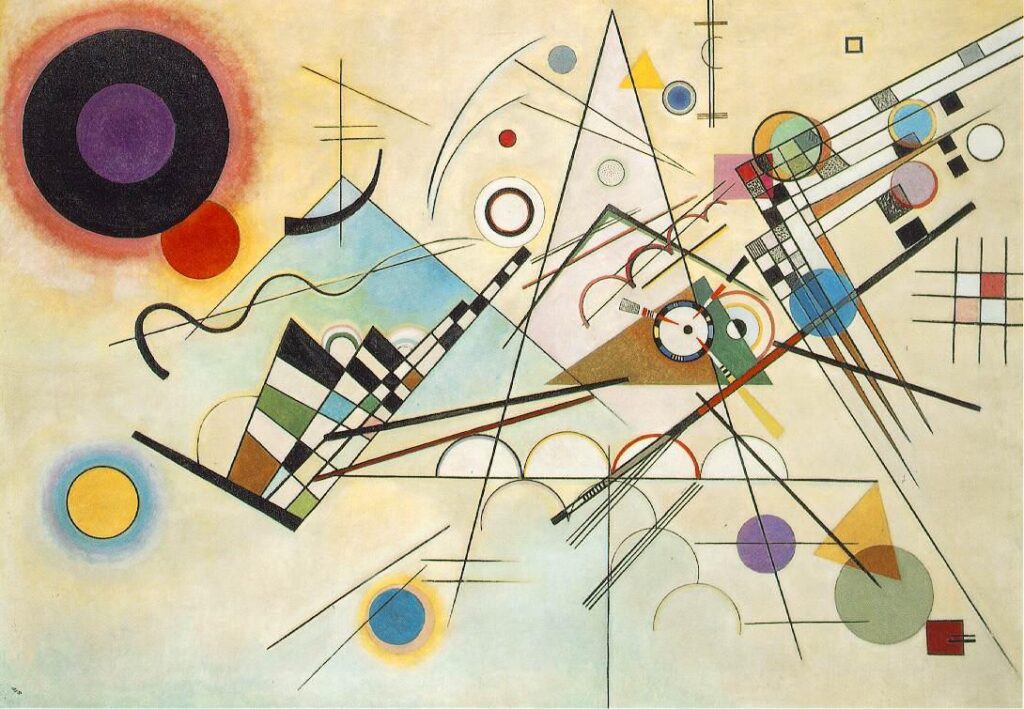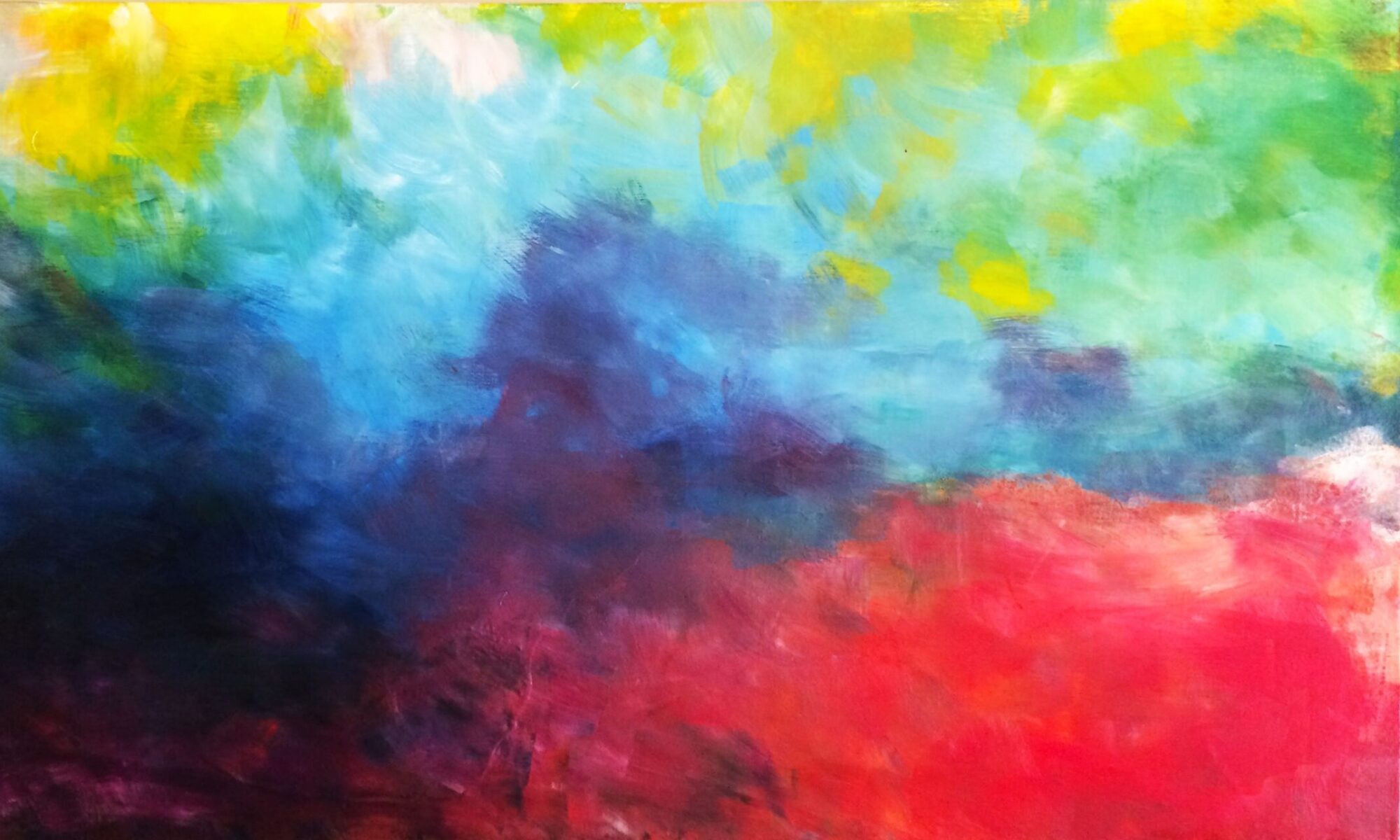Composition 8 by Wassily Kandinsky
 Fig.1 Wassily Kandinsky. Composition 8. 1923. Oil Painting. 140 cm x 201 cm. Solomon R. Guggenheim Museum, NY.
Fig.1 Wassily Kandinsky. Composition 8. 1923. Oil Painting. 140 cm x 201 cm. Solomon R. Guggenheim Museum, NY.The real purpose of life is different for all humans. In life, we always try to satisfy our needs and wants to feel happy since such feelings give us pleasure and make us forget our worries for a while. Food, sex, and art are the most common sources of pleasure that elevate our mood. Art and other pleasures are responsible for the release of a chemical in our brain called dopamine that is also known as a feel-good chemical. This same chemical is released during romantic love. To Greek philosophers like Socrates and Plato, art was believed to be an imitation of real life. Imitation could be defined as something that is an exact copy of real life. The perception of art as imitation changed in the 20th century when modern artists such as Wassily Kandinsky (1866-1944) introduced abstract artworks like Composition 8. Rather than being an exact copy of life, Kandinsky’s Composition 8 is a work of art that represents life the way the artist observed it and therefore refutes Socrates’ view of art.
Kandinsky, an artist from Russia, was a revolutionary painter who depicted life through shapes, lines, and colors. Composition 8 one of Kandinsky’s most appreciated paintings, is made up of geometrical shapes, such as circles, semi-circles, triangles, squares, and lines. Kandinsky’s Composition 8, which is displayed in the Guggenheim Museum in New York, was created in 1923 by using oil on canvas. This art piece contradicts the imitation theory, and such a painting could reflect almost anything. The reason behind refuting imitation theory was based on the idea that it does not include all the art, such as some absolute music and abstract art (“Composition VIII”).
Abstract art is something that is not the exact reflection of reality, but it could be based on life. According to Plato and Socrates, this Composition 8 would not be considered art because it is not imitation. However, American art critic Arthur Danto opposed the ideas of Socrates, by explaining to us that if we accept imitation theory, then we must believe that mirror images are also artworks. (Danto 33-44) In the early centuries, people used to imitate life, however, in the modern world, they are interested in other kinds of art as well. Danto’s ideas reject imitation theory and accept artworks like Composition 8.
We no longer need to imitate nature because now we have cameras with high resolution. This technology change provided a need to make art without imitation. People like Kandinsky played a meaningful role in making the art world broader and even interesting for modern generations because he rejected the idea of imitation and instead introduced new ideas. During Plato’s time, the perspective of art was narrow because of a lack of exposure to modern art. However, now in the 21st century, we are exposed to the growing knowledge of arts because of the internet and smartphones. This technological change provoked a need for a new theory of art because the old ones had a lot of restrictions.
In the making of Composition 8, Kandinsky used the idea of expressing music in the form of shapes like circles, triangles, and linear elements. This idea is said to be like the one used in a movement of arts that originated in Russia called constructivism. This movement borrows some ideas from Suprematism, which was another movement of arts-based on lines, colors, and shapes. To make Composition 8, Kandinsky used ideas from both art movements and blended them in the form of smooth and colorful shapes/lines (“The Art Story”). If we imagine Socrates to be alive today, we will observe a conflict in the art world because Socrates would never allow such art in his city.
Composition 8 is an artwork, even though Socrates would not accept it because art is about pleasure, but not about the way pleasure is received. Such art is unique and thus worthy since it is an imaginative road trip, which often depicts things going around us and teaches us to cope with them. It is like an entertaining teacher that raises our morals and simultaneously makes us happy. In this world, we teach our communities about physical and mental health but focus less on emotional health. Teaching emotional health is as much important as physical and mental health because it helps a person stay bold even in difficult times. This kind of knowledge makes humans better than other living beings because it makes our society mature, sympathetic, and responsible. I think we should not resist sharing such beautiful art with the world.
I believe that Plato’s and Socrates’ beliefs about art as imitation were narrow for today’s world. Art itself is everywhere around us because everything around us is the creation of an artist (God). Even if we look at our self, we could observe art with the help of art because for us to experience this external life, we need our five senses (smell, taste, touch, hear, sight). I completely support the idea of making abstract art because art has a broader perspective than the imitation of nature. I think art will keep expanding with time until people come to know that everything is an art in its way.
Works Cited
Kandinsky, Wassily. “Composition VIII, 1923.” Wassily Kandinsky, 1 Jan. 1970,
www.wassilykandinsky.net/work-50.php.
Danto, Arthur, ‘The Artworld’, ABQ Chapter 3, pp. 33-44.
www.uh.edu/~cfreelan/courses/1361/Danto.htm.
“Important Art by Wassily Kandinsky,” The Art Story, NP www.theartstory.org/artist-kandinsky-wassily-artworks.htm. Accessed 3 Nov 2018.




